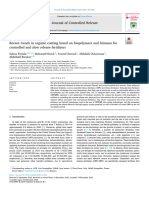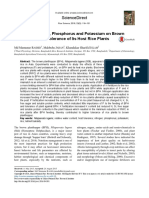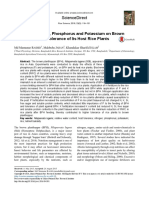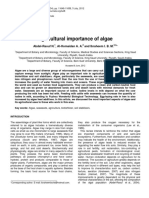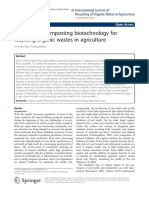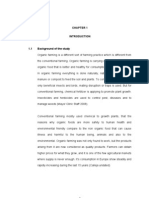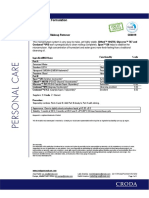0 ratings0% found this document useful (0 votes)
88 views12345
12345
Uploaded by
Aiza ArmeroOrganic fertilizers vary greatly in their nutrient content depending on their source material. Nitrogen and phosphorus levels tend to be lower in organic fertilizers compared to chemical fertilizers, and high moisture content can further dilute nutrient concentrations. Animal manures in particular can vary substantially in nutrient value based on factors like the animal's diet, bedding materials, age of manure, and storage conditions. While organic fertilizers release nutrients more slowly than chemical fertilizers, their application promotes bacterial growth which mineralizes nutrients and increases productivity, while also providing other benefits like increasing carbon dioxide and alkalinity levels in water. However, heavy applications can potentially lower dissolved oxygen in ponds.
Copyright:
© All Rights Reserved
Available Formats
Download as DOCX, PDF, TXT or read online from Scribd
12345
12345
Uploaded by
Aiza Armero0 ratings0% found this document useful (0 votes)
88 views4 pagesOrganic fertilizers vary greatly in their nutrient content depending on their source material. Nitrogen and phosphorus levels tend to be lower in organic fertilizers compared to chemical fertilizers, and high moisture content can further dilute nutrient concentrations. Animal manures in particular can vary substantially in nutrient value based on factors like the animal's diet, bedding materials, age of manure, and storage conditions. While organic fertilizers release nutrients more slowly than chemical fertilizers, their application promotes bacterial growth which mineralizes nutrients and increases productivity, while also providing other benefits like increasing carbon dioxide and alkalinity levels in water. However, heavy applications can potentially lower dissolved oxygen in ponds.
Original Title
12345.docx
Copyright
© © All Rights Reserved
Available Formats
DOCX, PDF, TXT or read online from Scribd
Share this document
Did you find this document useful?
Is this content inappropriate?
Organic fertilizers vary greatly in their nutrient content depending on their source material. Nitrogen and phosphorus levels tend to be lower in organic fertilizers compared to chemical fertilizers, and high moisture content can further dilute nutrient concentrations. Animal manures in particular can vary substantially in nutrient value based on factors like the animal's diet, bedding materials, age of manure, and storage conditions. While organic fertilizers release nutrients more slowly than chemical fertilizers, their application promotes bacterial growth which mineralizes nutrients and increases productivity, while also providing other benefits like increasing carbon dioxide and alkalinity levels in water. However, heavy applications can potentially lower dissolved oxygen in ponds.
Copyright:
© All Rights Reserved
Available Formats
Download as DOCX, PDF, TXT or read online from Scribd
Download as docx, pdf, or txt
0 ratings0% found this document useful (0 votes)
88 views4 pages12345
12345
Uploaded by
Aiza ArmeroOrganic fertilizers vary greatly in their nutrient content depending on their source material. Nitrogen and phosphorus levels tend to be lower in organic fertilizers compared to chemical fertilizers, and high moisture content can further dilute nutrient concentrations. Animal manures in particular can vary substantially in nutrient value based on factors like the animal's diet, bedding materials, age of manure, and storage conditions. While organic fertilizers release nutrients more slowly than chemical fertilizers, their application promotes bacterial growth which mineralizes nutrients and increases productivity, while also providing other benefits like increasing carbon dioxide and alkalinity levels in water. However, heavy applications can potentially lower dissolved oxygen in ponds.
Copyright:
© All Rights Reserved
Available Formats
Download as DOCX, PDF, TXT or read online from Scribd
Download as docx, pdf, or txt
You are on page 1of 4
CHAPTER 1
PROBLEM AND ITS SCOPE
RATIONALE OF THE STUDY
Organic fertilizers comprise a variety of plant-derived materials that range from fresh or dried plant
material to animal manures and litters to agricultural by-products (Wohlfarth and Schroeder, 1979;
Das and Jana, 2003; Kumar et al., 2004). The nutrient content of organic fertilizers varies greatly
among source materials, and readily biodegradable materials make better nutrient sources.
Nitrogen and phosphorus content is lower, often substantially lower, in organic fertilizers compared
to chemical fertilizers. Moisture content is another factor that reduces or dilutes the nitrogen and
phosphorus concentrations of organic fertilizers. Thus, it can be cost ineffective to transport
high-moisture organic fertilizer long distances. However, use of locally available sources is perfectly
reasonable if its use is consistent with the production strategy. Nutrient value of animal manures is
more variable than that of agricultural by-products. The animal's diet, the use and type of bedding
material, manure age, and how it was stored are factors that affect manure nutrient value; these
factors can vary seasonally on and among farms, and regionally or on a larger geographic scale. In
contrast, nutrient content of agricultural by-products is less variable but can be affected by the
industrial process used to produce the by-product. However, it always is advisable to analytically
determine the nutrient content of the organic fertilizer. The organic carbon content of organic
fertilizer can be of equal or greater importance than its nitrogen and phosphorus contents.
Application of organic fertilizer promotes increases in heterotrophic bacterial biomass, which
stimulates other secondary productivity and mineralizes nutrients to stimulate primary productivity
(Schroeder, 1978; Anderson, 1987; Colman and Edwards, 1987; Qin et al., 1995; Barkoh et al.,
2005). Furthermore, through respiration the increased bacterial population generates carbon dioxide,
which increases dissolved inorganic carbon available to phytoplankton, dissolves limestone to
increase pond total alkalinity, and can moderate increases in pH during periods of intense
photosynthesis. Also through respiration, the bacterial population consumes oxygen and heavy
applications of organic matter can result in low predawn pond dissolved oxygen concentration (Qin
et al., 1995). However, organic matter decomposition and nutrient mineralization occurs over days in
contrast to immediate nutrient availability from chemical fertilizer
You might also like
- SKM Organic Chem NotesDocument267 pagesSKM Organic Chem NotesGyanesh DwivediNo ratings yet
- Chapter 1. Jasper Jake Pajimola's GroupDocument4 pagesChapter 1. Jasper Jake Pajimola's GroupMitch MitchNo ratings yet
- Sorensen Et Al-2011-Journal of Plant Nutrition and Soil ScienceDocument12 pagesSorensen Et Al-2011-Journal of Plant Nutrition and Soil Sciencegou gouNo ratings yet
- Enhancement of Phenolics Flavonoids and Glucosinolates of Broccoli Brassica Olaracea Var ItalicaDocument8 pagesEnhancement of Phenolics Flavonoids and Glucosinolates of Broccoli Brassica Olaracea Var ItalicaNo VivoNo ratings yet
- Biomass and Nutrient Concentration of Lettuce Grown With Organic FertilizersDocument15 pagesBiomass and Nutrient Concentration of Lettuce Grown With Organic Fertilizersnhat039859No ratings yet
- 18esd027 Abu Darda AgricultureDocument9 pages18esd027 Abu Darda AgricultureAbu Darda ANo ratings yet
- Ijsrp p3818 PDFDocument4 pagesIjsrp p3818 PDFAndres BrutasNo ratings yet
- PechayDocument4 pagesPechaySannie Ong Monoy100% (1)
- Animal Manure - 2020 - Waldrip - Organomineral Fertilizers and Their Application To Field CropsDocument15 pagesAnimal Manure - 2020 - Waldrip - Organomineral Fertilizers and Their Application To Field CropsEduardo GuimaraesNo ratings yet
- Productivity of Sweet (Capsicum Annuum L) Under Different Balance Fertilization StrategyDocument26 pagesProductivity of Sweet (Capsicum Annuum L) Under Different Balance Fertilization StrategyLinggayo Mary annNo ratings yet
- Cow Dung For Ecofriendly and Sustainable Productive FarmingDocument2 pagesCow Dung For Ecofriendly and Sustainable Productive FarmingBMSCE FYP2019No ratings yet
- Das & Jana. Pond Fertilization Regimen - State-Of-The-ArtDocument32 pagesDas & Jana. Pond Fertilization Regimen - State-Of-The-ArtJTheron58No ratings yet
- Chemical FertilizersDocument13 pagesChemical FertilizersChandra VinnakotaNo ratings yet
- A Discussion On Integrated Effect of Compost and Urea Fertilizer On Growth and Yield of Crops: An Updated ReviewDocument7 pagesA Discussion On Integrated Effect of Compost and Urea Fertilizer On Growth and Yield of Crops: An Updated ReviewAdvances in Agriculture and BiologyNo ratings yet
- Fertilizante de Liberaã Ã o Controlada 4Document21 pagesFertilizante de Liberaã Ã o Controlada 4Geórgea Lorena ZampoloNo ratings yet
- Acidic SoilDocument15 pagesAcidic SoilNesma MamdouhNo ratings yet
- Growth Performance of Green Onion Applied With Different Dosage of Cow Manure and VermicompostDocument15 pagesGrowth Performance of Green Onion Applied With Different Dosage of Cow Manure and VermicompostChery SumagaysayNo ratings yet
- FINAL Growth Response of Different Organic Fertilizer On Rice Oryza Sativa L. .Doc 2Document36 pagesFINAL Growth Response of Different Organic Fertilizer On Rice Oryza Sativa L. .Doc 2CHRIST IAN JAN PALGANNo ratings yet
- Journal of Environmental ManagementDocument6 pagesJournal of Environmental ManagementFiena AzmiNo ratings yet
- Role of Soil Microorganisms in Improving P Nutrition of PlantsDocument12 pagesRole of Soil Microorganisms in Improving P Nutrition of PlantsGaby IklprNo ratings yet
- 3 - Review of LiteratureDocument26 pages3 - Review of LiteratureVinoth Kumar78% (23)
- Sustainability 11 02266 v2Document19 pagesSustainability 11 02266 v2Lady MendozaNo ratings yet
- Comparing The Efficacy of Organic and Inorganic Fertilizers On The Growth of Maize Zea Mays L PlantDocument5 pagesComparing The Efficacy of Organic and Inorganic Fertilizers On The Growth of Maize Zea Mays L Plantaccessiunya341No ratings yet
- 2018 IFA Integrated Plant Nutrient Management HighlightsDocument9 pages2018 IFA Integrated Plant Nutrient Management Highlightscarlos mosqueraNo ratings yet
- Blessing's Project Proposal-11 (1) - 1-1Document34 pagesBlessing's Project Proposal-11 (1) - 1-1onyeaghalajude0No ratings yet
- Effect of Inorganic Fertilizer, Vermicompost and Bio-Fertilizer On Quality, Content and Uptake of Nutrients in Sweet Corn (Zea Mays L. VarDocument6 pagesEffect of Inorganic Fertilizer, Vermicompost and Bio-Fertilizer On Quality, Content and Uptake of Nutrients in Sweet Corn (Zea Mays L. VarUtkarsh GoyalNo ratings yet
- 1 s2.0 S1672630816300026 Main PDFDocument13 pages1 s2.0 S1672630816300026 Main PDFtimur baratNo ratings yet
- Impact of Nitrogen, Phosphorus and Potassium On Brown Planthopper and Tolerance of Its Host Rice PlantsDocument13 pagesImpact of Nitrogen, Phosphorus and Potassium On Brown Planthopper and Tolerance of Its Host Rice PlantsDian GultomNo ratings yet
- Fertilizantes y Eficiencia 1976Document17 pagesFertilizantes y Eficiencia 1976Will2170No ratings yet
- Agricultural Importance of Algae: ReviewDocument11 pagesAgricultural Importance of Algae: ReviewNelson NicolasNo ratings yet
- ManureDocument14 pagesManurejulietanitta52No ratings yet
- WGVWTBRBTDocument19 pagesWGVWTBRBTmwah mwahNo ratings yet
- Thesis 04Document22 pagesThesis 04Marlexis ConacoNo ratings yet
- Thesis 04Document22 pagesThesis 04Marlexis ConacoNo ratings yet
- Soil Facts: Solid Cattle ManureDocument4 pagesSoil Facts: Solid Cattle ManureChand RaviNo ratings yet
- Exercise 6 Learning Module - 1st Semester 2023-2024Document25 pagesExercise 6 Learning Module - 1st Semester 2023-2024Aria MoonNo ratings yet
- Assessment of Integrated Poultry Manure and Synthetic Fertilizer Effects On Maize (Zea Mays) Growth and Soil Properties: A Study From Bayero University, KanoDocument15 pagesAssessment of Integrated Poultry Manure and Synthetic Fertilizer Effects On Maize (Zea Mays) Growth and Soil Properties: A Study From Bayero University, KanoInternational Journal of Innovative Science and Research Technology100% (1)
- A_Review_on_the_Effect_of_Organic_and_Chemical_Fer (1)Document6 pagesA_Review_on_the_Effect_of_Organic_and_Chemical_Fer (1)groarthNo ratings yet
- Response of Pechay Brassica Napus L PDFDocument5 pagesResponse of Pechay Brassica Napus L PDFElba Joy Alagao AbadNo ratings yet
- Applsci 13 01127 v2Document17 pagesApplsci 13 01127 v2NaztovenNo ratings yet
- Effect of Vermicompost and Biofertilizers On Yield and Soil PDFDocument3 pagesEffect of Vermicompost and Biofertilizers On Yield and Soil PDFAgricultureASDNo ratings yet
- Soil Fertility Management For Organic Crops: Vegetable Research and Information CenterDocument0 pagesSoil Fertility Management For Organic Crops: Vegetable Research and Information Centermastergeo35No ratings yet
- PR 2 Title DefenseDocument13 pagesPR 2 Title DefenseLucas IlaoNo ratings yet
- Tomato Nutrients Linked To PH, Phosphorus Management: Gary PullanoDocument4 pagesTomato Nutrients Linked To PH, Phosphorus Management: Gary PullanoJoshua De LeonNo ratings yet
- Research Chap 1Document9 pagesResearch Chap 1tanangelsyvilleNo ratings yet
- Bio efficacyofOrganicFormulationsonCropProduction AReviewDocument18 pagesBio efficacyofOrganicFormulationsonCropProduction AReviewArsh SidhuNo ratings yet
- 3is CompiledDocument35 pages3is Compiledyolayolayola1111No ratings yet
- Experimental Research GrouDocument15 pagesExperimental Research GrouSarabia VillaNo ratings yet
- ISER 84273 Pranov+Harale Journal+of+Survey+in+Fisheries+SciencesDocument20 pagesISER 84273 Pranov+Harale Journal+of+Survey+in+Fisheries+SciencesJaylo Patigdas AMVNo ratings yet
- Group 1 (Chapter 1-5)Document65 pagesGroup 1 (Chapter 1-5)Laarnie TubaleNo ratings yet
- Fertilizer and Sanitary Quality of Digestate Biofertilizer From The Co-Digestion of Food Waste and Human ExcretaDocument6 pagesFertilizer and Sanitary Quality of Digestate Biofertilizer From The Co-Digestion of Food Waste and Human Excretagiselle18melend1013No ratings yet
- Use of Vermicomposting Biotechnology For Recycling Organic Wastes in AgricultureDocument6 pagesUse of Vermicomposting Biotechnology For Recycling Organic Wastes in AgricultureStephani ArrochaNo ratings yet
- The Growth and Yield Performance of Brassica Alboglabra (Chinese Kale) Apply With Difference Rate of VermicompostDocument42 pagesThe Growth and Yield Performance of Brassica Alboglabra (Chinese Kale) Apply With Difference Rate of VermicompostRaja HasnizanNo ratings yet
- Complete Paper UNILADocument9 pagesComplete Paper UNILASITI KHOIRIYAH100% (1)
- IntroductionDocument1 pageIntroductionlouiethandagNo ratings yet
- Review of Related Literature - Food ShredderDocument12 pagesReview of Related Literature - Food ShredderAhmed Dhempsey Hali AbdulbasikNo ratings yet
- 18 SKM2Document8 pages18 SKM2omniakhalid910No ratings yet
- Final Research PaperDocument21 pagesFinal Research PaperChristine FernandezNo ratings yet
- Revell 2012Document7 pagesRevell 2012Tosin AwonusiNo ratings yet
- AFA1 MOdule 2 - EditedDocument13 pagesAFA1 MOdule 2 - EditedJea-Ann JariolNo ratings yet
- A Fertility Program for Growing Vegetables - With Information on Soil, Manures and Use of ChemicalsFrom EverandA Fertility Program for Growing Vegetables - With Information on Soil, Manures and Use of ChemicalsNo ratings yet
- Phycobiliproteins (1987) PDFDocument225 pagesPhycobiliproteins (1987) PDFJackNo ratings yet
- Study On Mechanical Behaviour of Banana Fiber Reinforced Epoxy CompositesDocument30 pagesStudy On Mechanical Behaviour of Banana Fiber Reinforced Epoxy Compositespramo_dassNo ratings yet
- Food Packaging Technology: BS-Final Year Lecture #2 (A) Packaging Material (Paper)Document11 pagesFood Packaging Technology: BS-Final Year Lecture #2 (A) Packaging Material (Paper)SONIA NABINo ratings yet
- Biology SS2 First Term - Edudelight - Com-1Document65 pagesBiology SS2 First Term - Edudelight - Com-1oyussuf2008No ratings yet
- H2O2 ReportDocument16 pagesH2O2 ReportShōyōHinataNo ratings yet
- Chapter 10 DisinfectionDocument11 pagesChapter 10 DisinfectionNyasha MunyatiNo ratings yet
- p1 Coverage Animal Nutrition - Chapter 5Document33 pagesp1 Coverage Animal Nutrition - Chapter 5jayr ludoviceNo ratings yet
- 2 The Chemicals of Living Cells - AnswersDocument2 pages2 The Chemicals of Living Cells - AnswersChia Rou PorNo ratings yet
- What Is Emulsion PaintDocument10 pagesWhat Is Emulsion Paintabdilquadri ishaqNo ratings yet
- Chemical Engineering Journal: SciencedirectDocument9 pagesChemical Engineering Journal: SciencedirectasadNo ratings yet
- Chemistry Paper 2 HLDocument14 pagesChemistry Paper 2 HLstella FrancisNo ratings yet
- Recent Advances in Polysaccharides Stabilized Emulsions For EncapsulationDocument17 pagesRecent Advances in Polysaccharides Stabilized Emulsions For EncapsulationRayito HernándezNo ratings yet
- C830 Migration & Non-Volatile-Matter Content TesterDocument4 pagesC830 Migration & Non-Volatile-Matter Content TesterHan ArdiansyahNo ratings yet
- Alcohols 2 QPDocument10 pagesAlcohols 2 QPHarpreetNo ratings yet
- F (C) D Mini Float Level Switch - B0Document28 pagesF (C) D Mini Float Level Switch - B0Tu WentingNo ratings yet
- Chapter - 3 - Multiple ChoiceDocument24 pagesChapter - 3 - Multiple ChoicewaqasaliNo ratings yet
- Biochemical Changes During The Storage of High Hydrostatic Pressure Processed Avocado PasteDocument7 pagesBiochemical Changes During The Storage of High Hydrostatic Pressure Processed Avocado PastePaul Jefferson Flores HurtadoNo ratings yet
- 3RD TERM S 1 - ChemistryDocument30 pages3RD TERM S 1 - ChemistryAdelowo DanielNo ratings yet
- Amendment No. 2 August 2019 TO Is 2508: 2016 Polyethylene Films and Sheets - SpecificationDocument2 pagesAmendment No. 2 August 2019 TO Is 2508: 2016 Polyethylene Films and Sheets - SpecificationSOMNATHNo ratings yet
- Makeup Remover 2Document1 pageMakeup Remover 2zaryab khanNo ratings yet
- Aging of Whiskey Spirits in Barrels of Non Traditional VolumeDocument117 pagesAging of Whiskey Spirits in Barrels of Non Traditional VolumeJeremyNo ratings yet
- Solo Smoke Detector Tester: Safety Data SheetDocument5 pagesSolo Smoke Detector Tester: Safety Data SheetSATISHNo ratings yet
- Functional Group AnalysisDocument20 pagesFunctional Group AnalysisandreaNo ratings yet
- Fungicide Families or Groups - Pacific Northwest Pest Management HandbooksDocument6 pagesFungicide Families or Groups - Pacific Northwest Pest Management HandbooksDavid SilverNo ratings yet
- 3-Example Lab Report-2 - 240301 - 095910Document7 pages3-Example Lab Report-2 - 240301 - 095910Hana BatrisyiaNo ratings yet
- Complain LetterDocument5 pagesComplain LetterArgha SaputraNo ratings yet
- Reagents LOA ListDocument20 pagesReagents LOA ListAntony JohnsonNo ratings yet
- 7th Tex 3105Document75 pages7th Tex 3105Farzak Faysal M FarabiNo ratings yet
- Chemistry Letters, 2013, Vol. 42, # 10 P. 1235 - 1237Document3 pagesChemistry Letters, 2013, Vol. 42, # 10 P. 1235 - 1237rrgodboleNo ratings yet














